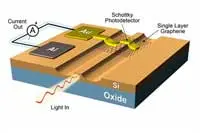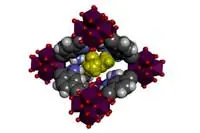Electronics News
Archive : 7 July 2016 год
 Described as an important step towards graphene integration in silicon photonics, researchers from the Graphene Flagship have shown how graphene can enable silicon photodetection in the telecommunication wavelengths.
Described as an important step towards graphene integration in silicon photonics, researchers from the Graphene Flagship have shown how graphene can enable silicon photodetection in the telecommunication wavelengths.
According to the team, silicon based photodetectors currently used in optical communications do not perform well in the near infrared range. While this has been overcome by integrating germanium absorbers with standard silicon photonic devices, this process is complex.
Addressing the issue, the team interfaced graphene with silicon on chip to create high responsivity Schottky barrier photodetectors. These devices are said to achieve a responsivity of 0.37A/W at 1550nm using avalanche multiplication. This, it adds, is comparable to the responsivity of silicon germanium detectors.
Professor Andrea Ferrari from the Cambridge Graphene Centre said: “This is a significant result which proves that graphene can compete with the current state of the art by producing devices that can be made more simply, cheaply and work at different wavelengths.” This will pave the way for graphene integrated silicon photonics, he noted.
He said that, while the potential for the detector has been demonstrated, a graphene based modulator will also be needed in order to provide a full, low energy optical telecommunication system.
“The Flagship is working hard on this problem,” he continued. “It is a great challenge and a great opportunity for Europe, as there is such high added value to the devices, it will be cost effective to manufacture them in Europe; keeping the value of the technology within the European community.”
The work was performed by the University of Cambridge, the Hebrew University and John Hopkins University.
Author
Graham Pitcher
Source: www.newelectronics.co.uk
 Researchers from KU Leuven, led by Ivo Stassen and Rob Ameloot, have built a sensitive electronic nose with metal-organic frameworks (MOFs) to detect pesticides and nerve gas in very low concentrations.
Researchers from KU Leuven, led by Ivo Stassen and Rob Ameloot, have built a sensitive electronic nose with metal-organic frameworks (MOFs) to detect pesticides and nerve gas in very low concentrations.
The best-known electronic nose is the breathalyser. As drivers breathe into the device, a chemical sensor measures the amount of alcohol in their breath. This chemical reaction is then converted into an electronic signal, allowing the police officer to read off the result. Alcohol is easy to detect, because the chemical reaction is specific and the concentration of the measured gas is fairly high. But many other gases are complex mixtures of molecules in very low concentrations. Building electronic noses to detect them is thus quite a challenge.
“MOFs are like microscopic sponges,” Stassen explained. “They can absorb quite a lot of gas into their minuscule pores. We created a MOF that absorbs the phosphonates found in pesticides and nerve gases.”
The team’s detector is the most sensitive gas sensor to date and can be used to find traces of chemical weapons such as sarin or to identify the residue of pesticides on food.
Stassen claimed: “The concentrations we’re dealing with are extremely low: parts per billion – a drop of water in an Olympic swimming pool – and parts per trillion.”
Professor Rob Ameloot said that the chemical sensor can easily be integrated into existing electronic devices, by applying the MOF as a thin film over the surface of an electric circuit, for instance. Therefore, it’s fairly easy to equip a smartphone with a gas sensor for pesticides and nerve gas.
“Further research will allow us to examine other applications as well,” Prof Ameloot explained. “MOFs can measure very low concentrations, so we could use them to screen someone’s breath for diseases such as lung cancer and MS in an early stage. Or we could use the signature scent of a product to find out whether food has gone bad or to distinguish imitation wine from the original. This technology, in other words, offers a wide range of perspectives.”
Pic: The MOF used in this study consists of organic molecules (in grey and black) and metal ions (zirconium, in purple). Between these molecules are little holes that can absorb the phosphanates (in yellow). Image credit KU Leuven - Centre for Surface Chemistr
Author
Tom Austin-Morgan
Source: www.newelectronics.co.uk

